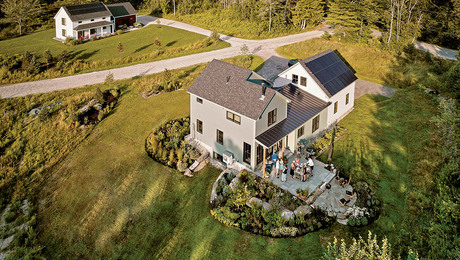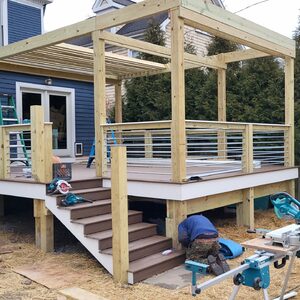I took over building a deck from a contractor who left the job site. Unfortunately, I didn’t realize until after I bid the job that the deck is not square. Further complicating matters is the fact that there are 4 levels. Some levels are square and some aren’t.
The top level is a landing from the home’s back door and is about 4’x8′. This is relatively square – less than 1/2″ out of square over the 8’width. Next is a step down to the main deck. This step also is reasonably square.
After that comes the main deck, about 12×10. This is about 1 5/8″ out of square. I’m installing Ipe with EB-TY hidden deck fasteners.
After that is another step down to a patio. It is approximately as square as the main deck, i.e. not. I’m less worried about the steps around 3 sides of the perimeter of the deck. The main deck is my main worry.
Should I work from the ledger board out? My carpenter suggested we work from the outside in and cover some of the difference with the PVC riser. The PVC would effectively cover as much as a 3/4″gap resulting from the out of square deck. That would leave a little more than 3/4″ out of square, i.e. a long triangular Ipe plank visible.
Alternately, we could try to work out the difference slowly working from the back of the deck (top level that’s next to the house)OR from the from the front of the deck.
Any suggestions?
Thanks ,
D


















Replies
Could you work out from the house side and add either a tapered filler strip or some blocking to support the uneven cantilever of the final board? That strip or blocking can get faced with your trim, so as long as that last board is adequately supported, no one will ever know what the deck structure underneath is doing.
Or am I missing something?
k
what if you did a bread board(band) around the deck that is square and then shim the pvc board to give a within reason of having the same reveal underneath to the breadboard?
start from outer edge going in, and make one edge slightly looser than the other until you make it up. an inch in eight feet is doable without being noticed.
Alternatively, you could keep them all tight by using a plane to shave some off each as you lay them to make slightly tapered pieces.
Welcome to the
Taunton University of Knowledge FHB Campus at Breaktime.
where ...
Excellence is its own reward!
Just change the rim joists to bring the sides square. Are we talking all 4 sides are a different length or the deck section is pushed out of square?
If your adding posts to this deck, get it set up now cause it will be easier to deal with now.
Got pictures?
Edited 4/25/2009 8:43 am ET by USAnigel
Have you already started the work? If not, I'd explain to the customer why you can't assure a decent job from what you have to work with, re-bid as if starting from scratch, and dismantle what's there. Salvage as much lumber as you can, then do it right.
Actually, you might want to do this even if you have already started the work but not too deep into it yet.
~ Ted W ~
Cheap Tools! - MyToolbox.net
Meet me at House & Builder!
I may well be missing something, but I don't really understand what the big deal is. I certainly wouldn't be looking to dismantle the whole thing, unless there are other problems.
The surface of the deck doesn't have to conform to the framing at all, really, except at the ledgers/risers, where some finagling may be needed.
When you build a curved deck, the edges are supported by framing which approximates the surface, but is obviously not curved. You simply let the boards cantilever where they are running in the right direction, and block/fill in where the edge board is half on/ half off.
But, as I said, I may be missing something.
k
I'm not there, so can't see what you can. Working with what's there may be perfectly okay, given a little tweeking here and there. I just threw the idea out there because I personally hate to 'fix' somebody elses shaddy workmanship.
I guess a lot of it depends on the customer. Some of my clients would prefer that I start from scratch and do it right, while other's don't see the point in spending the extra money to do it over.
Some things to look for is whether the posts are set in concrete or gravel. That's been discussed extensively in this forum, that setting them directly in concrete will cause them to rot out faster.
What kind of fasteners did he use? If he used galvanized nails with PT lumber, they will probably rust - something else that's been discussed a lot here.
How is the ledger attached? Will it hold up for the long term? Are the joists all crown side up? There could be any number of things wrong with it that only you can see.
If the customer wants to just tweek what's there and get it done, then that's what should be done. I'd push for taking it down and knowing I did it right, so thought I'd throw the idea out there for consideration. ~ Ted W ~
Cheap Tools! - MyToolbox.netMeet me at House & Builder!
I just threw the idea out there because I personally hate to 'fix' somebody elses shaddy workmanship.
Well, amen to that, brother. I know exactly what you mean.
Good point about double checking the footings and fasteners, too.
k
Is it out of square because of sides being cut to different lengths... or is it just racked? If the decking isn't on yet, why can't you just rack it true? What am I missing? When I frame a deck I often don't bother squaring it up until all the joists are in. Then we rack it square and shoot a diagonal on the bottom to hold it true until it's decked. Of course I also install my posts after it's roughed, but you could cut this connection, no?
As others have suggested, simply make the deck square.
dieselpis suggests, to move things until they are square. If it's just a case of the framing being racked, what he proposes should not be to troublesome once the fastneners are removed, unless you are dealing with flush posts. In which case may have to move some posts as well.
If unequal sides are the problem fur out or adjust the framing until things are right.
You can make it as square as you want to. And as long as the structure is sound, there is no need to dismantle and start over.
You can even hide a 1/4 inch out of square in the trim boards without changing the framing. so that things are perfectingly square as far as deck surface goes.
Edited 4/25/2009 7:42 pm by alrightythen
Like Piffin said.....
Start at the outside edges. Lay each and every piece of decking so that it makes up a tiny bit of the difference -- maybe 1/32" for each board.
And over 10' of decking, 1/32" per board will make up a bit more than an inch. Do just a bit more than 1/32, and your problem is solved completely.
THanks for your suggestions. I haven't put a picture on Breaktime yet so I hope this works. A picture really is worth a 1,000 words. The picture show the 4 levels of framing plus the 5th and bottom level which is granite. I think that I'm going to have to go with spacing the decking an inch a fraction over the course of about 50" or 1/16 per 3.5 inch Ipe board. That will absorb just over an inch of the 1 1/2" error. The remainder (just under 1/2") will be hidden under the overlapping 3/4" PVC riser trim. The decking won't be pefectly parralel to the riser but the alternatives are less appealing. THe owner prefers this to taking it apart. It would be nice if we could rack the deck but it is firmly secured to 3 footings (marked with Xs in circles on the "main" deck). The previous carpenter doubled all the 2x8 PT risers so I'm guessing that that also would make racking the deck more difficult. Also, levels 1 and 2 are square and are attached to level 3 so they'd have to be moved after racking level 3. And, last but not least, the granite step at the bottom is set as is the patio, barely visible at the bottom. Everything would have to be changed... it aint worth it at this point. I'm not sure however, if I'd be better off starting at the far edege of the deck and working toward the house where it's easier to hide errors or working out from the house. If anyone has experience working with EB-TY fasteners working toward the house, I'd appreciate hearing.I would also like to learn more about galvi nails, PT and concrete not being compatible. I haven't heard this. Thanks again,
D
Hey Don, Theres been alot of good suggestions so far all of which will work. After seeing your picture, I would probably use custom furring strips on the risers as Alreadythen pointed out. It will have an added bonus of ventilating the back of your risers.I always start my decking at the outside and work towards the house..........can't stand seeing a 2-1/2" board on the outside of a deck with 6" boards. Almost all the decks I do are picture framed, so it looks weird with a 2-3" board sandwiched between two 5-1/2"ers.I have only seen one ipe deck using 3-1/2" wide boards and it was about 5 years old. They had put 1 stainless screw (not trimhead) at each joist in the middle of each board and no cupping at all.......looked really sharp.
Thanks ,I feel better about working from the outside of the deck toward the house. I'm still uneasy about furring out the risers because it will impede on the tread below, making the tread only 10 1/2" wide on one end and the full 12" wide on the other. Don
I'm confused...... (not the first time or last). If levels 1 and 2 are square, how does furring out level 3 to square make 1-1/2" difference in the steps? I'm probably not seeing something I should. If thats the case you may be best with cheating the boards. Disregard the furring out method.
You're right re: levels 1 and 2 but it will mess up level 4, also a step. I could then fur out level 4 but then the reveal/tread on the granite will be off.
D
What TedW was saying about the concrete was that if the posts are set down into holes filled completely with concrete, (like many fence posts), they will tend to rot out faster than if they were set in gravel, or in brackets on top of a footing.
There's something to it, but I personally have set many posts in concrete that have been holding up for 15-20 years so far. I always put a layer of gravel at the bottom of the hole, so the post is in a "collar" of concrete, not a "cup", to avoid trapping water.
Brackets set into concrete that hold the posts above grade are ideal, but don't serve structurally in all cases.
I wouldn't freak out if the deck you're working on has posts set in concrete.
The thing about PT and fasteners is that the chemicals (especially the copper) have a reaction to the metal and tend to corrode it.
The galvanized coating slows down the process a bit, but to really insure a long lasting connection, stainless steel bolts/nails/screws/hardware are recommended. If you're using lightly galvanized hangers, you should isolate them from the wood with something, like peel and stick flashing, or even tar paper.
That said, galvanized fasteners are still used by most folks, and many are specifically advertised as ok for ACQ PT. Simpson tie sells Z-Max hardware for ACQ PT which has extra galvanization, but it's still just galvanized. Stainless steel is a good idea if it's in the budget, and you want your deck to last a long time, or if collapse will cause death or injury.
I wouldn't freak out if the deck you're working on doesn't have stainless steel fasteners.
k
THanks K,Got it and I'm in good shape. Good to know for future where it could matter more. D